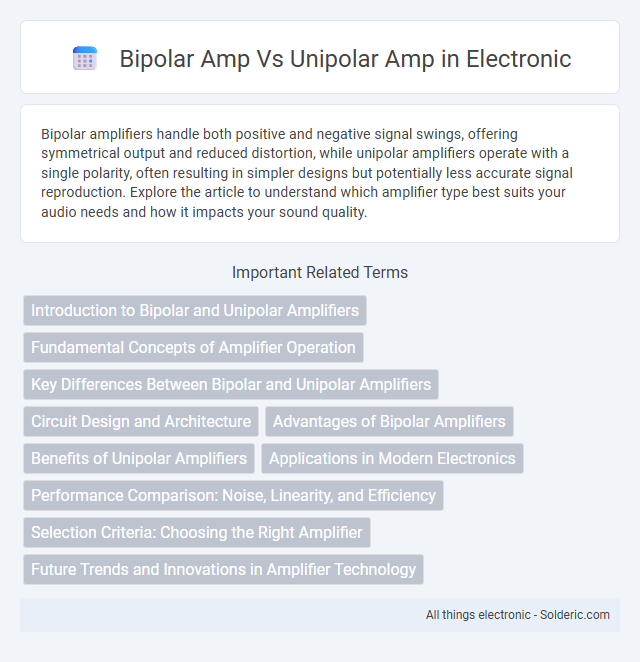Bipolar amplifiers handle both positive and negative signal swings, offering symmetrical output and reduced distortion, while unipolar amplifiers operate with a single polarity, often resulting in simpler designs but potentially less accurate signal reproduction. Explore the article to understand which amplifier type best suits your audio needs and how it impacts your sound quality.
Comparison Table
| Feature | Bipolar Amplifier | Unipolar Amplifier |
|---|---|---|
| Transistor Type | Bipolar Junction Transistor (BJT) | Field Effect Transistor (FET) |
| Input Impedance | Low to moderate (~kO) | High (MO to GO) |
| Output Impedance | Moderate | Low |
| Noise Level | Higher noise | Lower noise |
| Gain | Higher voltage gain | Moderate voltage gain |
| Linearity | Good linearity | Excellent linearity |
| Power Consumption | Higher | Lower |
| Speed | Higher frequency response | Slower compared to BJT |
| Applications | Audio amplifiers, RF amplifiers | Low-noise preamplifiers, impedance buffering |
Introduction to Bipolar and Unipolar Amplifiers
Bipolar amplifiers utilize bipolar junction transistors (BJTs) that conduct using both electron and hole charge carriers, offering high gain and fast switching speeds ideal for analog signal amplification. Unipolar amplifiers employ field-effect transistors (FETs), such as MOSFETs, where conduction relies on a single type of charge carrier, providing high input impedance and low noise performance. Both amplifier types serve distinct applications based on their electrical characteristics, frequency response, and power efficiency.
Fundamental Concepts of Amplifier Operation
Bipolar amplifiers use both positive and negative voltage swings to amplify signals, enabling symmetrical output and improved linearity, crucial for high-fidelity audio and RF applications. Unipolar amplifiers operate with a single polarity voltage supply, limiting output swing but often simplifying circuit design and power management. Understanding these fundamental operational differences highlights how bipolar amplifiers excel in full-range signal amplification while unipolar amps are preferred for low-noise and low-power scenarios.
Key Differences Between Bipolar and Unipolar Amplifiers
Bipolar amplifiers use bipolar junction transistors (BJTs) that rely on both electron and hole charge carriers, offering higher gain and faster switching speeds compared to unipolar amplifiers, which use field-effect transistors (FETs) and depend on a single type of charge carrier. Bipolar amps typically exhibit lower input impedance and higher noise levels, whereas unipolar amps provide higher input impedance and better thermal stability, making them suitable for low-noise applications. Choosing between bipolar and unipolar amplifiers depends on your need for speed, gain, input impedance, and noise performance in your circuit design.
Circuit Design and Architecture
Bipolar amplifiers utilize complementary pairs of transistors in push-pull configurations, enabling efficient linear amplification with balanced output stages, which reduces distortion and improves fidelity. Unipolar amplifiers rely solely on a single type of transistor, such as field-effect transistors (FETs), leading to simpler circuits but often requiring additional stages for balanced output and higher distortion. The architecture of bipolar amps supports higher gain bandwidth products and superior thermal stability compared to unipolar designs, making them preferable for high-precision analog applications.
Advantages of Bipolar Amplifiers
Bipolar amplifiers offer higher gain and better linearity compared to unipolar amplifiers, making them ideal for precision applications. Their superior frequency response and lower distortion enhance audio and signal processing quality. You benefit from improved performance and reliability in high-speed and high-frequency circuits using bipolar amplifier technology.
Benefits of Unipolar Amplifiers
Unipolar amplifiers offer improved signal integrity by reducing distortion and noise levels compared to bipolar amplifiers, making them ideal for precision applications. Their simpler design results in lower power consumption and enhanced thermal stability, which extends device longevity. Unipolar amplifiers also provide faster switching speeds, benefiting high-frequency and low-voltage circuitry performance.
Applications in Modern Electronics
Bipolar amplifiers are widely used in radio frequency and analog signal processing applications due to their high gain and linearity. Unipolar amplifiers, often based on field-effect transistors (FETs), excel in low-noise and high-input-impedance scenarios, making them ideal for sensor interfaces and precision instrumentation. Your choice between bipolar and unipolar amplifiers impacts the efficiency and accuracy of modern electronics in communications, audio devices, and measurement equipment.
Performance Comparison: Noise, Linearity, and Efficiency
Bipolar amplifiers typically exhibit lower noise levels due to their high transconductance and better linearity, making them ideal for high-fidelity applications requiring minimal signal distortion. Unipolar amplifiers, such as MOSFET-based designs, provide superior efficiency and higher input impedance but may suffer from increased noise and non-linearity compared to bipolar counterparts. Performance trade-offs between noise, linearity, and efficiency depend on the specific application, with bipolar amps favored in precision analog circuits and unipolar amps preferred for power-efficient, high-frequency systems.
Selection Criteria: Choosing the Right Amplifier
Selection of bipolar versus unipolar amplifiers depends on the application's voltage and current requirements, signal linearity, and power efficiency needs. Bipolar amplifiers excel in high-speed, high-gain applications due to their superior linearity and low noise characteristics, making them ideal for analog signal processing and radio frequency circuits. Unipolar amplifiers offer lower power consumption and simpler biasing, suited for low-voltage, low-noise scenarios such as sensor signal conditioning and battery-powered devices.
Future Trends and Innovations in Amplifier Technology
Emerging innovations in amplifier technology are steering bipolar amplifiers toward higher switching speeds and improved thermal performance through advanced semiconductor materials like gallium nitride (GaN). Unipolar amplifiers are benefiting from integration with digital signal processing (DSP) techniques, enhancing efficiency and reducing distortion in audio and RF applications. Future trends emphasize hybrid amplifier designs that combine bipolar transistors' high gain with unipolar devices' low noise for superior overall performance in communications and power electronics.
Bipolar amp vs Unipolar amp Infographic

 solderic.com
solderic.com